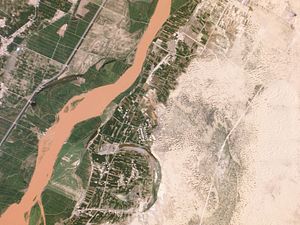China has just approved a RMB1.15 billion (roughly $170 million) rainmaking project. The bulk of the money will be funneled into cloud-seeding operations and technology, targeting the country’s dry northwestern region that encompasses Ningxia, Gansu, Qinghai, and Xinjiang provinces.
According to the Qinghai Provincial Climate Center, the weather phenomenon El Nino left the upper reaches of the Yellow River “dry to very dry” throughout 2016. The 5,464 km long Yellow River, which is often referred to as the cradle of Chinese civilization, originates in the Qinghai-Tibet Plateau and runs from west to east through the northern part of China, feeding much of the agriculture in that part of the country. The Tangnaihai water station, located near the Yellow River’s source, reported that 2016 was the driest year since 2003, with water levels dropping by more than 30 percent between June and September.
Similarly, the Yangtze River’s source is located in Qinghai province and flows southeast via Yunnan and then eastwards where it discharges into the ocean at Shanghai. It is the longest river in Asia and a major shipping thoroughfare, contributing an approximate 20 percent of China’s GDP.
Both rivers are integral to both the agriculture and water supply of the country. While there’s little official information about China’s water supply issues, Probe International reports that four-fifths of China’s water is in the south, most notably the Yangtze River basin, while half of China’s people and two-thirds of its farmland are in the north, where the Yellow River basin is located. Beijing has water scarcity problems usually associated with countries such as Saudi Arabia: a mere 100 cubic meters per person, per year. The water table under the capital has dropped by 300 meters (nearly 1,000 feet) since the 1970s.
Cloud seeding aims to increase rainfall and involves the dispersion of substances and chemicals that serve as cloud condensers into the atmosphere. The aim is to alter the microphysical processes within clouds so that condensation reaches a saturation point, resulting in rain.
He Shengcun, an official at the Qinghai provincial government’s “weather influencing” office, told China News Service that between 2006 to 2016, cloud seeding had increased rainfall by 55 billion cubic meters.
A feasibility study by the China Meteorological Administration (CMA) found that rainfall and snow could be increased in an area of 960,000 sq km, 10 percent of the country’s territory, if the proposed investments were made. The National Development and Reform Commission (NDRC) has approved the budget to upgrade eight aircraft currently in its fleet and purchase four new planes, develop 897 rocket propelled devices, and digitally connect over 1,800 devices to control systems.
The current weather patterns are not surprising given the shift in the global El Nino Southern Oscillation (ENSO) weather patterns, which affect much of the Asia-Pacific, and the trend toward global warming, according to Dr. Liu Zhonghui from the Department of Earth Sciences at The University of Hong Kong.
“In general, it is much drier in northwestern China while wetter in southern China. It is not surprising as southern China is dominated by the monsoon circulation system while northwestern China is dominated by the westerly circulation. Southern China may be indeed affected by the ENSO in recent years. Some studies support the notion that when the climate is getting warmer, the south is getting even wetter,” Liu told The Diplomat.

































